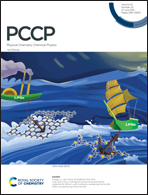Temperature-dependent circular conversion dichroism from chiral metasurfaces patterned in Dirac semimetal Cd3As2†
Abstract
Chiral metasurfaces patterned with L-shaped holes in a thin film of Dirac semimetal Cd3As2 are designed. The impact of temperature T on circular conversion dichroism, mainly characterized by circular polarization differential transmittance (CPDT), is studied by rigorous coupled-wave analysis. The results show that decreasing T will give rise to the appearance of much more narrow CPDT peaks and dips, and the maximum differential transmittance between two opposite circularly polarized light can reach above 0.60 by optimizing the structural parameters at 80 K. As the T increases, the differential transmittance gradually decreases, and the CPDT peak and dip values exhibit variation tendencies of ‘Z’ and ‘S’ types, respectively. Two simple formulae of CPDT extreme values with respect to T are derived, predicting that the decreasing tendency will reach saturation when T ≥ 500 K. Differing from the wavelength-independent variation trend of differential transmittance, CPDT extremum positions mainly show a blueshift (redshift) tendency at the wavelength λ > 10 μm (λ < 5 μm) as the T increases. Moreover, evolutions of CPDT with various factors including the thickness of Cd3As2, incident and azimuth angles are also clearly unveiled.



 Please wait while we load your content...
Please wait while we load your content...